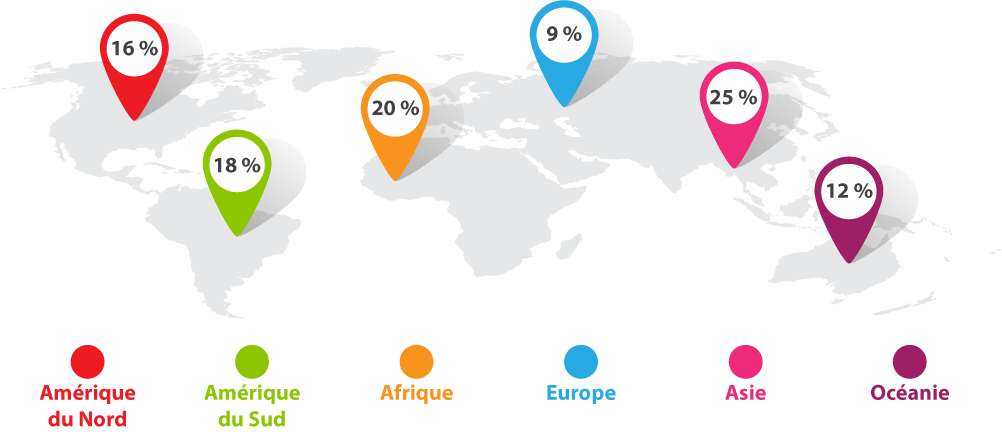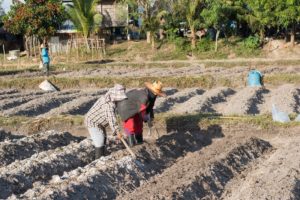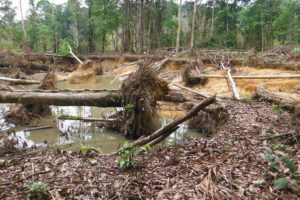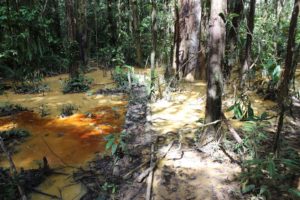The gold of today
The gold
sector
Supply and demand of gold 2019:
Annual supply of recycled gold: 1,311 tons
- Ration mined gold/recycled gold by user sectors (jewelry, technology and finance) : unknown
- Grandfathered recyclable and recycled gold prior 2012, which not requires a determination of origin: unknown
- 80% of the world's gold is imported and refined by Switzerland (about 40%) and Dubai (about 40%)
Source: “World Gold Council”
Production of gold by continent
(2005-2014 averages)

Source: GFMS, Thomson Reuters, Gold Survey 2015
Annual demand for gold by sector
(tons)
![]() Jewellery
Jewellery
![]() Investments and banks
Investments and banks
![]() Technology
Technology
Consumption for jewellery
(ratio/estimation)
consumption in technological industry
(ratio/estimation)
Increase of the foreseen demand:
Growth estimations of the electronic material sales are 7.7% per year, through to 2023 (ref. Statistica); the jewellery sector anticipates a growth of 300% through to 2035 (source: Paul Ziminski Diamond Analytics)
These two industries use recycled gold and also mined gold as well, then it is estimated that the extraction of gold will double over the next 10 years, with proportional impacts on the populations and their environment.
Impacts of the
exploitation of mines
Social impact
75%
of the global gold production is mined in developing countries (World Gold Council). Miners operate in many countries in the world and the workers receive little income. Apart from the human cost of these epidemics, there is also a considerable economic cost through downtime from illness, transporting people who are ill or injured to health facilities, recruiting and retraining costs and so on.
820 Million
The number of inhabitants who live in the tropical forests in 2018 total 820 million (284 million in Africa, 85 million in Latin America, 451 million in Asia) (FAO, The State of the world’s forests 2018)
4.2 million
In 2013, the mining companies directly employed an excess of one million persons, with more than three million indirect employees (people who work for the suppliers and services in the mining sector).
40%
of the global economy directly lies in nature and its services (eco tourism, water, food, medicine…) according to an environmental study conducted by the United Nations.
Environmental impact
35 Million km2
Or one quarter (1/4) of the emerged grounds of the planet are subject to extreme degradation or desertification phenomena (FAO 2018).
12 Million
The quantity of hectares in the tropical forest that were lost in 2018 amounts to 12 million (World resources institute (WRI). This is three times the surface of Switzerland, and is to be added to the volumes of hectares lost in previous years. The total surface of forests in the world is a bit more than 4 billion hectares, or 31% of the emerged surface. The net annual loss of forests (i.e. the sum of all the losses of forest, exceeds the gains) from 2000 to 2010 was 5.2 million hectares, or a bit more than the surface of Switzerland.
More than 27,000
Number of living species that are threatened by extinction, or about 27% of the known species.
These comprise of 40% of the amphibians, 25% of the mammals, 14% of the birds, 31% of the sharks, 33% of the corals (IUCN 2019). The forests, in particular the moist tropical forest, shelter certain ecosystems which are the richest in species and the most diverse on the planet.
lately
Becoming aware
Sustainable sourcing goes further than responsible sourcing, incorporating practices that actively generate social and environmental good beyond laws and standards, with a longer-term vision of continuity, conservation of resources and empowerment of actors in the supply chain.
(Gold) Sustainable sourcing is Doing Right and Doing Well, as mentioned above, but additionally it is:
Doing Good: Protecting and generating positive impacts for society and the environment.
Source: BETTER BUSINESS IN THE JEWELLERY SECTOR: THE DIFFERENCE BETWEEN RESPONSIBLE AND SUSTAINABLE SOURCING
some figures:
- 150 billionEuro: worldwide mined gold annual value (2019)
- 6 billion Euro: UNICEF annual Budget (2018)
- 4 billion Euro: Bill and Melinda Gates Foundation annual budget (2018)
- 1.5 billion Euro: MSF's annual budget (2018)
- 0.3 billion Euro: WWF Annual Budget (2019)
Gold certification labels:
LBMA, RJC, IRMA, FAIRTRADE





